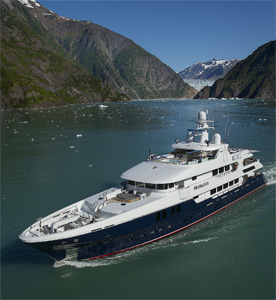In the early 2000s, a couple of shipyards in the Pacific Northwest began refining the traditional hand lay-up process of composite boat construction by implementing a vacuum infusion method, whereby negative pressure is applied to extract air and at the same time impregnate the mold with resin. Vancouver, Wash.-based Christensen Shipyards was one of those innovators.
In the early days, small sections of a build’s bulkheads and superstructure were sealed with a thin plastic vacuum bag while resin flowed through feeder lines and infused the cavity. Infusion in small sections was necessary to ensure the adequate distribution and adherence of the resin; each section had to be painstakingly checked for air pockets to ensure structural integrity.
Vacuum infusion was found to have many benefits. The process significantly reduces the amount of solvents and particulates used, reducing exposure for yard workers. It also results in a structure that is not only thinner when compared to layer upon layer of hand-rolled resin, but yields a 25 percent increase in strength and stiffness. Compared to steel builds, the amount of extra volume in the interior of an infused composite build can amount to as much as one additional stateroom.
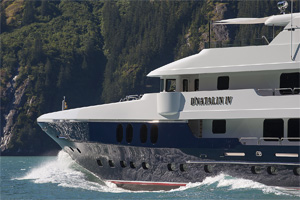 |
|
D’Natalin IV’s owner headed to Alaska’s Tracy Arm on the mega-yacht’s maiden voyage. |
So the vacuum infusion method was enthusiastically embraced at Christensen, whose success over the years can largely be credited to its focus on new technology and innovation. After several years of refining the process, Christensen infused its first full hull in a single pull in 2010 — Hull 035, the 162-foot Remember When.
It was this milestone that led to the construction of D’Natalin IV, a 164-foot fully infused motor yacht that slipped into the water to be delivered to its owners in early July 2014.
“(The owners) loved different elements of their prior yachts, a Feadship and a Delta, but really felt the only way they were going to get everything they wanted in a yacht was to build something designed to suit the way they like to live onboard,” said Christian Bakewell, broker and newbuild specialist with the Superyacht Division of Merle Wood & Associates. “Because she is built entirely of composite, significant space is saved because this material requires less insulation than steel or aluminum. The result is a 164-foot boat with the interior volume and deck spaces of something closer to 180 feet.”
And D’Natalin IV is strong.
“The infusion technology that we utilize is the same that Boeing uses for the Dreamliner,” said Christensen President and CEO Joe Foggia. “We engineer our boats to be much stiffer — five times stronger — than steel. We are at about 120,000 pounds per square inch while steel will be 30,000 pounds per square inch tensile strength. We don’t want a boat that flexes.”
 |
The overall brief for D’Natalin IV’s build was straightforward and simple: The owner wanted six staterooms and large exterior deck spaces with both dining and lounging areas. The yacht also had to come in at under 500 gross tons, as private yachts over this volume are subject to the same restrictions and operational constraints as large commercial vessels.
In addition, the owners wanted to build in America, as they felt the U.S. shipyards were on par with their European counterparts. Bakewell presented Christensen as an option, as he had worked with the yard in the past and it already had a 164-foot hull in build that could be assumed.
“The Christensen Custom 164-foot series ticked all of the boxes in the brief,” said Bakewell, who created a 300-page specification that would become the road map for the build. “I cannot stress enough the importance of taking your time at this stage, making sure all of the details are right and the systems chosen before setting about and building the yacht. Often in the rush to get started too many details are overlooked, which eventually slows the build time down and costs the owner money.”
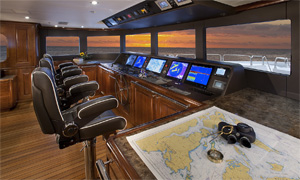 |
|
Project manager Robert Emerson said the owner “was very clear in his direction. He wanted the most current available contract items installed” throughout the vessel, including the electronics. |
Coming on the heels of the 2008 recession that rocked the yacht building industry and forced many yards to drastically reduce staff or even close their doors, the order for D’Natalin IV posed an interesting situation for Christensen, which had recently implemented the lean manufacturing process.
“One of the challenges we faced was how to meet a very short delivery date and rebuild our work force after the 2008 economic downturn, when we had just closed on a couple of other new projects as well,” said project manager Robert Emerson.
A longtime Christensen employee, Emerson was familiar with the ebbs and flows of the company’s production over the past 20 years, but the resurgence of operations that took the work force from 75 to nearly 430 was nothing short of exhilarating.
“We started an extensive hiring program in order to meet our contractual obligations,” he said. “Since Joe Foggia had implemented lean manufacturing into the company prior to D’Natalin IV’s owner purchasing the yacht, we were able to hire and train new employees in a short amount of time to ensure we met our delivery obligations.”
Recalling his first meeting with D’Natalin IV’s owner, Emerson said, “he was very clear in his direction. He wanted the most current available contract items installed, from electronics to navigation, audio/visual and appliances, and involved his family in the process when making many of the interior finish decisions.”
The owner visited the yard frequently to check in on the build process and specify the finish details, and the project became an enjoyable one for the now-bustling shipyard.
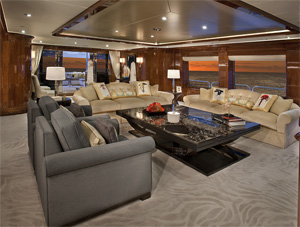 |
|
Carol Williamson & Associates designed the interior of D’Natalin IV. The décor includes American black walnut in the guest staterooms and marble and granite stonework throughout. |
Working with Carol Williamson & Associates of Portland, Ore., the owner specified interior décor that features American black walnut in the six guest staterooms and maple in the crew quarters, incorporating a blend of high-gloss and satin finish. The owner’s office features wood-coffered ceilings. There is book-matched marble and granite stonework throughout and a silver-leaf recessed overhead in the main salon.
D’Natalin IV’s interior is serviced by an elevator accessing all four decks. The yacht is fitted with the latest in audio/visual equipment, with an integrated system that allows all electronic and motorized features — entertainment, lighting, temperature, blinds, etc. — to be iPad-controlled.
Vancouver, Wash.-based Hyak Electroworks provided the systems integration and monitoring network, called SIMnet. It controls and monitors everything that has power on the boat.
“We have the ability to communicate with any part on the boat from anywhere in the world,” Foggia said. “If we want to turn up the A/C in the pilothouse, we can. We can also troubleshoot, diagnose and operate any of the systems from the yard. This includes generators, sewage systems, everything.”
D’Natalin IV is the first Christensen boat built to Tier 3 emissions standards. Its twin 3512C Caterpillar diesels also allow this proven hull to exceed standard expectations in terms of range and speed, affording a 4,000-nm range at 10 knots.
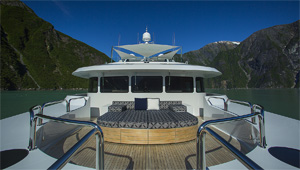 |
|
The owner also specified large exterior deck spaces with both dining and lounging areas. |
Bakewell said the owner’s last yacht was plagued by generator exhaust issues due to an older system. So, on the new yacht the brief was simple. The owner wanted to neither see nor smell generator exhaust from either the wet-exhaust overboard system or from the dry stacks at the mast.
“After researching several systems, we decided to go with DCL’s Marine-X diesel particulate filters,” Bakewell said. “Of all of the systems we studied, we really liked DCL’s combination of low energy use coupled with straightforward (infrequent) maintenance. … The effectiveness (of the system) was underscored during the yacht’s christening when 40 people enjoyed the festivities stationed directly underneath the exhaust as it exited the mast with nothing more than a faint heat signature to testify to the generator being on.”
As the proud owners took delivery of their latest yacht, Christensen returned its focus to its 430 employees and the nine projects it has underway: two 120-foot motor yachts being built in collaboration with Ocean Alexander; a 142-footer; five 164-footers, and a 130-foot fully infused submarine-hunting drone commissioned by the U.S. military.
In the Pacific Northwest, embracing innovation is paying dividends.

